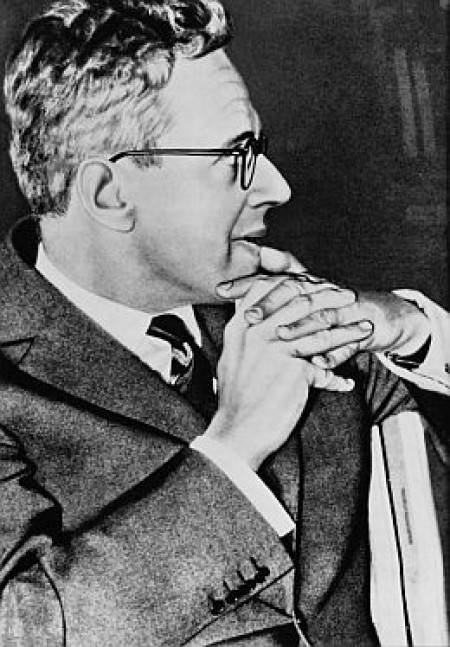
28 May 1923, Dicsőszentmárton – 12 June 2006, Vienna
György Ligeti came to Budapest from his homeland, Transylvania, in 1945, and left Hungary a decade later, in 1956. He spent half of these ten years as a student, and half as a teacher at the Music Academy, but this short time was enough for Ligeti to leave a deep impression on Hungarian musical life.
He was born in Dicsőszentmárton in 1923, and completed his secondary education in Kolozsvár. From 1941 onwards he came into close contact with Ferenc Farkas, who taught there, and made a deep friendship with András Szőllősy, who studied in Budapest at that time. He completed the course in composition between 1945 and 1950, studying at first with Sándor Veress and then with Farkas. As a student at the Music Academy, he participated fully in the vibrant musical life there, visiting Bence Szabolcsi's classes in the history of styles, and then his Bartók seminar. It was here that he put forward his analysis of the Medvetánc, which was later also published as an article. János Breuer recalled the young musician with a brilliant intellect as follows: "Everything he touched became very clear, but at the same time he also demonstrated the complexity of the seemingly simple Bartókian structures." On completing his studies, he went on a folksong collecting tour in Romania, and, as a result, wrote a still valid summing up of the basic principles of harmonic order in Romanian folk music. In the autumn of 1950 he was appointed teacher of music theory, and, almost as part of his occupational duties, wrote a textbook, Classic Harmonics, and the related set of examples, Classic Harmonic Order, which remained in use as teaching aids for a long time.
In the Hungary of the 1950's Ligeti was regarded as a prolific and successful young composer. His works, largely based on folksong adaptations, were played at many concerts, and Hungarian Radio also recorded several of them. But under the surface, there lay dormant repressed compositional ambitions, since Ligeti, even though cut off from contemporary Western European experiments, guessed the existence of new paths (for example in Musica ricercata or the Metamorphoses nocturnes) which he could not put before a public that was being "protected" even from Bartók's avantgarde works. His secret listening to foreign broadcasts and hidden correspondence with German colleagues strengthened him in the resolution: he could only gain freedom as a creative artist at the price of emigration.
He went initially to Cologne, where he learned the fundamentals of electronic music by the side of Karlheinz Stockhausen. The breakthrough came with the German premieres of two of his orchestral pieces, the Apparitions and the Atmospheres (1960 and 1961), which launched Ligeti's name in the new musical life of Europe. He was welcomed as a new talent, who was breaking out of the dead end of serial music towards the composing of sound textures, perhaps without people even guessing that the precursor of this method was thought out by the composer already in his Budapest "isolation". A victorious march began, as a result of which Ligeti became one of the best known contemporary composers. Besides his series of masterpieces, another factor in this was his radiant personality, which, with its lively and independent spirit, captivating lecturing-teaching style, and marked political stances was able to raise matters relating to contemporary music, often the concern of only a small circle, to matters of public interest. As a teacher – initially in the 1960's in Stockholm, then between 1973 and 1989 in Hamburg – he created a school, from which emerged several recognized young German composers (Wolfgang von Schweinitz, Detlef Müller-Siemens, Manfred Stahnka).
The tone of his music, just as his thinking as a whole, was always primarily above nations, but from the seventies onwards characteristic Hungarian elements increasingly appeared in it, first only in an ironic garb (Passacaglia ungherese and Hungarian Rock), then in a more and more essential role (in the Magyar Etüdök /Hungarian Studies/ composed to Weöres poems, and in certain movements of the Piano Concerto and the Violin Concerto). He visited Hungary in 1970, as a member of the panel of judges of a composers' competition, then in 1979 Hungary celebrated the world-famous composer with a composer's evening devoted to his works and a volume of interviews with him by his friend, Péter Várnai. Though his visits remained sporadic, and his works have still not taken the place they deserve in Hungarian concert life (his opera, Le Grand Macabre, had only two performances in the Opera House), it is beyond doubt that the one-time student and teacher of the Music Academy, whether he lived in Vienna, Hamburg or Paris, always belonged a little to Budapest as well. He died in Vienna in 2006.
P. H.


